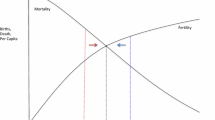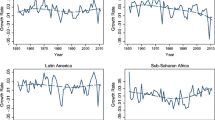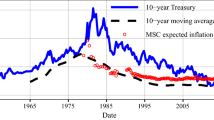Abstract
The economic implications of demographic change depend on steadfast investments in research and development; replenishment of the human capital stock diminished by retiring Baby Boomers; and raising college attainment rates. This way the United States can leverage its diverse, fast-growing population to harness a demographic dividend—the productivity boost enabled by declining fertility—while also fueling economic growth, restocking the Social Security system, and bolstering global competitiveness.







Similar content being viewed by others
Notes
Although the Hispanic presence in North America predates the establishment of the United States as a sovereign nation, until 1970 the U.S. Census Bureau did not use a consistent question to identify Hispanics. Rather, surnames were used in the Southwest to identify Mexicans; Puerto Ricans were enumerated in the Northeast; and Cubans were identified in Florida if they were foreign born. See Tienda and Mitchell [2006] for further details.
References
Aud, S., W. Hussar, F. Johnson, G. Kena, E. Roth, E. Manning, X. Wang and J. Zhang . 2012. The Condition of Education 2012. Washington D.C.: U.S. Department of Education, National Center for Statistics).
Demos, 2011. The State of Young America: The Databook. Demos and The Young Invincibles. http://www.demos.org/state-of-young-america (accessed October 23, 2014).
Frey, William H. 2015. Diversity Explosion: How New Racial Demographics are Remaking America. Brookings Institution Press.
Gordon, Robert J. 2013. “The Great Stagnation of American Education.” New York Times, Opinion Pages (September 7).
Gribble, James N. 2012. “South Korea’s Demographic Dividend.” Population Reference Bureau, http://www.prb.org/Publications/Articles/2012/south-korea-population.aspx (accessed July 30, 2014).
Howden, Lindsay M., and Julie A. Meyer . 2011. Age and Sex Composition: 2010. U.S. Department of Commerce Economics and Statistics Administration, U.S. Census Bureau.
Humes, Karen R., Nicholas A. Jones and Roberto R. Ramirez . 2011. Overview of Race and Hispanic Origin: 2010. U.S. Census Bureau.
Lutz, Wolfgang, William P. Butz and Samir K.C . 2014. World Population & Human Capital in the Twenty-first Century. Oxford: Oxford University Press.
National Center for Education Statistics (NCES), 2014. Actual and Projected Numbers for Enrollment in Public Elementary and Secondary Schools, by Race/Ethnicity: Fall 1997 through Fall 2022. Projections of Education Statistics to 2022, Table 3 (41st Edition).
OECD, 2012. Education at a Glance 2012: OECD Indicators. OECD Publishing, http://www.oecd.org/edu/eag2012.htm (accessed October 23, 2014).
OECD.Stat, 2015. GERD as a Percentage of GDP. OECD Publishing, http://stats.oecd.org/Index.aspx?DataSetCode=MSTI_PUB.
Pew Hispanic Center, 2006. From 200 Million to 300 Million: The Numbers Behind Population Growth. Pew Hispanic Center.
Social Explorer, 2010. Data Dictionary: Census 2010. Social Explorer.
Tienda, Marta and Faith Mitchell edited by. 2006. Multiple Origins, Uncertain Destinies: Hispanics and the American Future. National Academy Press.
U.S. Census Bureau, 1901. Census of the United States, 1900. Department of the Interior.
U.S. Census Bureau, 1953. Census of the United States, 1950. U.S. Census Bureau).
U.S. Census Bureau, 1973. Census of the United States, 1970. U.S. Department of Commerce, Bureau of the Census.
U.S. Census Bureau, 1992. 1990 Census of Population, General Population Characteristics, United States. U.S. Department of Commerce, Bureau of the Census.
Ruggles, S., Katie Genadek, Ronald Goeken, Josiah Grover and Matthew Sobek . 2010. Educational Attainment – 2010 American Community Survey 1 Year Estimates. Integrated Public Use Microdata Series: Version 6.0 [Machine-readable database]. Minneapolis: University of Minnesota.
UNESCO Institute for Statistics, 2015. Expenditure on Education as % of GDP (from government sources). UNESCO http://data.uis.unesco.org/?queryid=181 (accessed March 25, 2015).
U.S. Department of Health, Education, and Welfare, 1976. Annual Report of the Commissioner of Education Fiscal Year 1975. Washington DC: U.S. GPO.
Acknowledgements
I would like to thank Cara Carpenito for her technical support in preparing the presentation and the manuscript.
Additional information
Based on a presentation in the NBER Panel on Economic Implications of Demographic Change at the NABE Annual Meeting, October 11, 2015.
*Marta Tienda is Maurice P. During ’22 Professor of Demographic Studies and Professor of Sociology and Public Affairs at Princeton University and past president of the Population Association of America. She is a member of the American Academy of Arts and Sciences, the American Academy of Political and Social Sciences, and the National Academy of Education. Currently Dr. Tienda serves as an independent trustee of the Teachers Insurance Annuity Association (TIAA), the Alfred P. Sloan Foundation, and the Jacobs Foundation of Switzerland. She is a member of the White House Commission on Educational Excellence for Hispanics, the Research Advisory Committee of the American Education Research Association and the Board of Population Reference Bureau. Previously she served on the boards of Brown University, the Federal Reserve Bank of New York, the W.T. Grant Foundation, the Carnegie Corporation of New York, the Kaiser Family Foundation, and the Russell Sage Foundation. Dr. Tienda received a B.A. from Michigan State University (Spanish, 1972) and a Ph.D. in sociology from the University of Texas at Austin (1976).
Rights and permissions
About this article
Cite this article
Tienda, M. Economic Implications of Demographic Change: Diversity Dividend or Deficit?. Bus Econ 51, 11–17 (2016). https://doi.org/10.1057/be.2016.1
Published:
Issue Date:
DOI: https://doi.org/10.1057/be.2016.1




